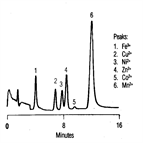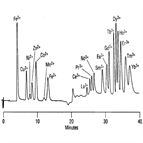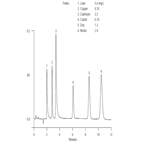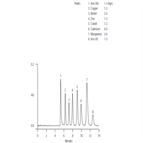Find methods for your needs
Refine by Feature
Displaying 1-4 of 4 results for Tag: Transition Metals
TN25: Determination of Transition Metals in Complex Matrices by Chelation Ion Chromatography
Instrument Type: ICThis technical note describes chelation concentration, a selective concentration method, coupled directly to an ion chromatograph for the determination of transition metals in complex matrices. This method, Chelation Ion Chromatography, combines analyte concentration and matrix elimination with analytical separations and sensitive detection for transition and lanthanide metals. The result is a chromatographic technique that permits trace and ultratrace determination of metals in variety of sample matrices, especially those high in alkali and alkaline earth metals.
TN23: Ion Chromatography of Lanthanide Metals (Part 3/3: Simultaneous Separation of Transition Metals and Lanthanide Metals)
Instrument Type: ICA class separation of lanthanide metals from transition metals is achieved by taking advantage of the electroselectivity differences between transition metal complexes and lanthanide metal complexes. Transition metals form stable monovalent or divalent anionic complexes with PDCA, while lanthanide elements form stable trivalent anionic complexes with PDCA.
TN10: Determination of Transition Metals by Ion Chromatography Using Oxalate Buffer Eluent
Instrument Type: ICThe IonPac CS5A column has both cation and anion exchange capacity, allowing metals to be separated as cations or anions on a single column. This is called a mixed mode separation.Transition metals are separated as both cationic and anionic complexes with the oxalate chelating agent added to the eluent.The metals are detected by measuring the absorbance at 530 nm of the complex formed with the postcolumn PAR reagent.
TN10: Determination of Transition Metals by Ion Chromatography Using PDCA Eluent
Instrument Type: ICThe IonPac CS5A column has both cation and anion exchange capacity, allowing metals to be separated as cations or anions on a single column. This is called a mixed mode separation.Transition metals are separated as anionic complexes with the PDCA chelating agent added to the eluent. The metals are detected by measuring the absorbance at 530 nm of the complex formed with the postcolumn PAR reagent.




